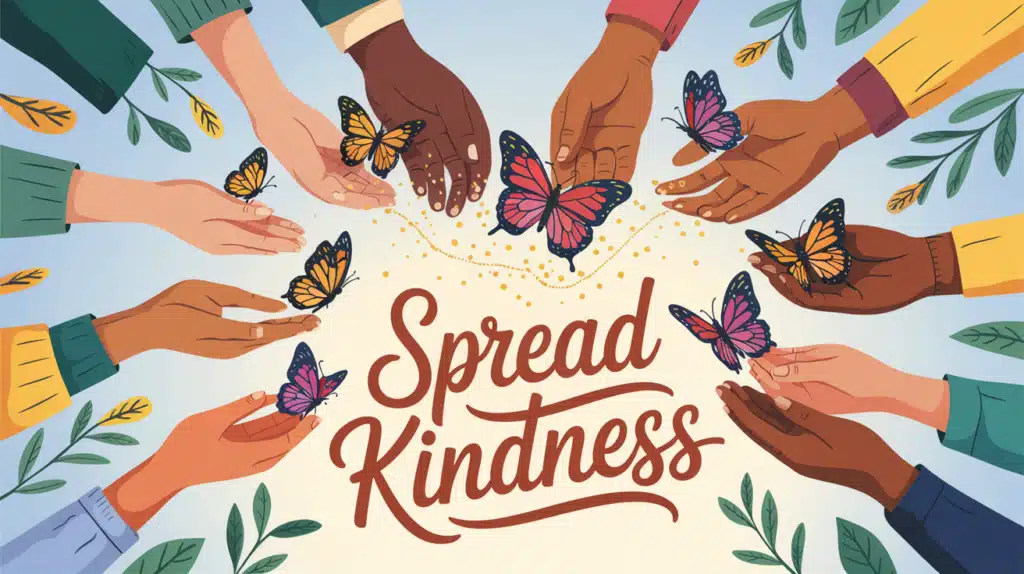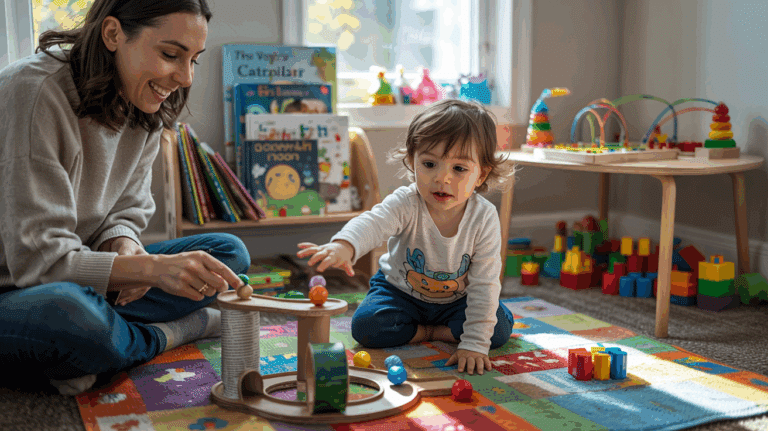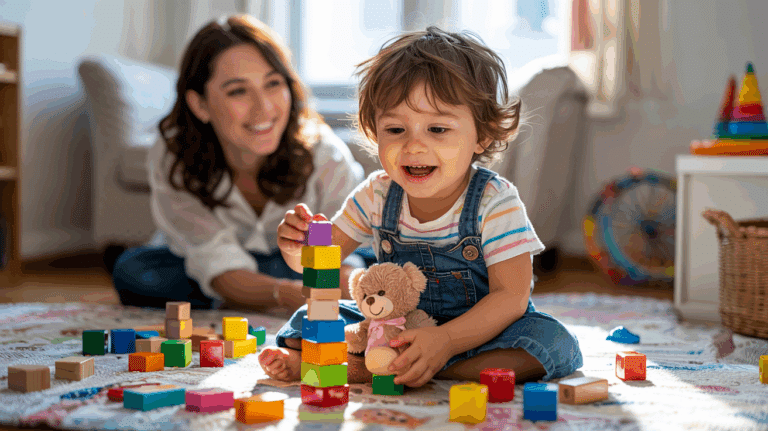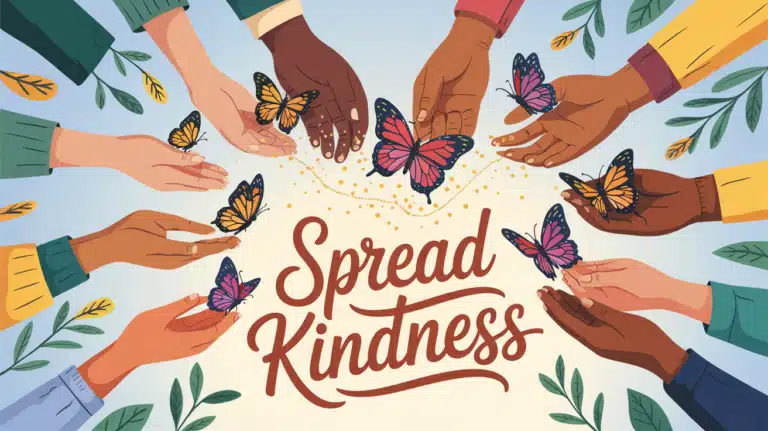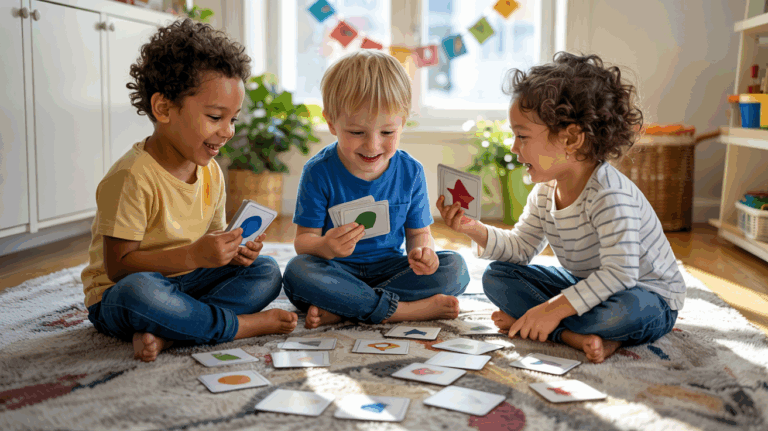Attention Parents and Educators, this collection is packed with practical ideas for your kindness mission! We’ve gathered 27 simple but powerful activities designed to nurture compassion in children of all ages.
Your action into kindness begins here with tested activities that require minimal supplies but create maximum impact. These fun, meaningful projects help kids develop empathy while making a real difference in their communities.
The following pages contain easy-to-follow instructions that transform everyday moments into opportunities for growth.
Remember: we’re building a generation of caring individuals. These activities aren’t just fun—they’re building blocks for a more compassionate world, one small act at a time.
Why Kindness Matters in Childhood Development
Kindness helps kids grow in amazing ways! When children learn to be kind early on, they build important life skills that stay with them forever.
Being kind helps kids make friends more easily. Other children want to play with someone who shares toys and says nice things. This helps them feel happy at school and in their neighborhood.
Kind kids also feel better about themselves. When a child helps someone else, their brain releases happy chemicals. It’s like getting a little reward inside their head!
Learning kindness teaches children to think about others’ feelings. This skill, called empathy, helps them understand different viewpoints and solve problems with friends.
Parents can easily encourage kindness at home through simple activities. Even small acts like feeding a pet or writing thank-you notes teach big lessons.
The best part? Kind children often grow into caring adults who make the world a better place!
Simple Yet Powerful Kindness Activities for Kids
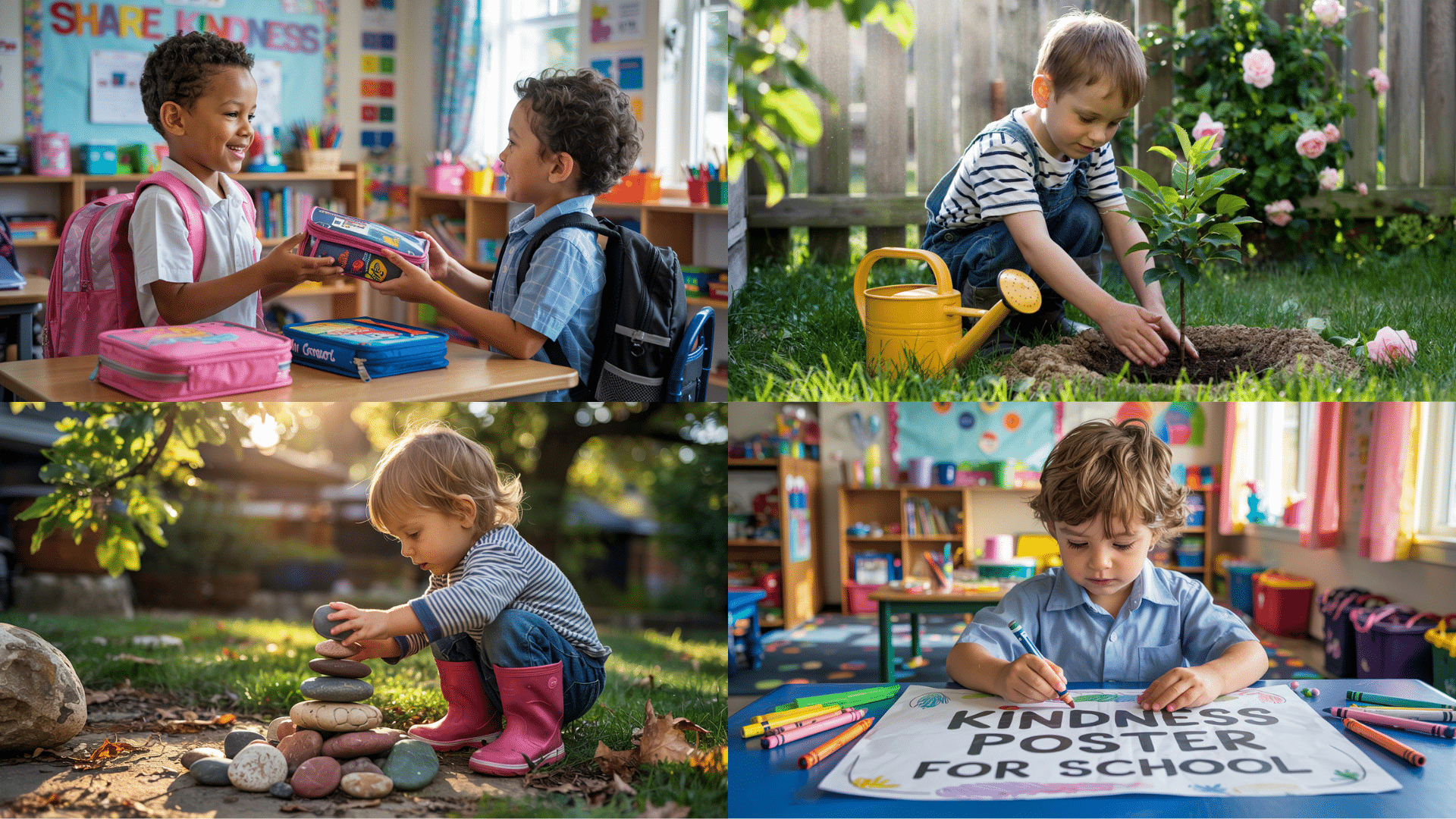
These Activities for Kids are fun and easy ways to show you care about others. Even small things—like sharing a snack or writing a nice note—can make someone’s day a lot better!
1. Create a Compliment Jar
Children can write kind words, positive affirmations, or happy memories on slips of paper and store them in a jar. Whenever someone feels down, they can pull one out for a boost of positivity.
- Why it works: Encourages emotional expression and reinforces positive self-talk
- Supplies needed: Jar, colorful paper, pens or markers
2. Donate Toys they’ve Outgrown
Ask kids to gather toys they no longer use and sort them for donation to shelters, hospitals, or charities. This teaches them about giving to those in need and makes room for gratitude.
- Why it works: Instills generosity and creates awareness of others’ needs
- Supplies needed: Gently used toys, donation bag or box
3. Help Bake Treats for a Neighbor
Involve kids in baking cookies, muffins, or bread to deliver to neighbors or elderly community members. It teaches hospitality, patience, and the joy of giving.
- Why it works: Encourages sharing, strengthens neighborly connections
- Supplies needed: Baking ingredients, utensils, gift wrapping or box
4. Make Kindness Rocks
Let kids paint rocks with kind messages or colorful designs and place them in public spaces for others to find. It creates spontaneous moments of joy for strangers.
- Why it works: Combines artistic expression with anonymous kindness
- Supplies needed: Smooth rocks, acrylic paint, paintbrushes, clear sealer spray
5. Write Letters to Seniors
Children can write letters, draw images, or create cards to mail or deliver to residents in senior centers. These letters often become keepsakes for lonely elders.
- Why it works: Nurtures empathy and reduces isolation among seniors
- Supplies needed: Stationery, envelopes, crayons or markers, stamps
6. Offer to Help a Classmate with Homework
Encourage kids to support a peer who’s struggling with schoolwork or new concepts. Helping someone understand a tough topic strengthens both kids’ learning.
- Why it works: Builds collaboration skills and promotes academic kindness
- Supplies needed: Homework materials, notebook, quiet workspace
7. Leave Happy Notes in Library Books
Have kids write short, encouraging messages and slip them inside random library books for others to learn. It’s a creative way to surprise and uplift someone’s day.
- Why it works: Inspires joy through anonymous acts of kindness
- Supplies needed: Small paper slips, markers or pens, tape (optional)
8. Start a Family Kindness Calendar
Create a monthly calendar filled with one small act of kindness each day for the family to do together. It builds consistency and gets everyone involved in giving.
- Why it works: Promotes routine kindness and meaningful family bonding
- Supplies needed: Printable calendar, stickers, pens or dry-erase board
9. Organize a Mini Clean-Up Day
Get kids involved in cleaning up litter at the park, school grounds, or neighborhood streets. It teaches responsibility and care for public spaces.
- Why it works: Builds environmental stewardship and community dignity
- Supplies needed: Trash bags, gloves, tongs or sticks, hand sanitizer
10. Share Snacks at School
Encourage your child to bring an extra snack or share part of theirs with a peer who might have forgotten theirs. It’s a simple but impactful act of generosity.
- Why it works: Reinforces empathy and sharing habits
- Supplies needed: Extra packaged snacks, napkins, school approval if needed
11. Decorate Lunch Bags for a Local Shelter
Children can draw images or write cheerful messages on lunch bags used for food programs. It adds a personal and loving touch to meals for those in need.
- Why it works: Blends creativity with service to uplift others
- Supplies needed: Paper lunch bags, markers, crayons, stickers
12. Say Thank You to a Bus Driver or Janitor
Have kids recognize the everyday heroes around them by saying thank you or making a card for school staff. These often-overlooked workers deserve kindness, too.
- Why it works: Teaches appreciation for essential and support roles
- Supplies needed: Thank-you card, stickers, a smile
13. Plant a Tree for Someone Special
Let your child plant a tree or flower in honor of a friend or family member, teaching them how to nurture life while giving back to nature.
- Why it works: Promotes environmental care and symbolic giving
- Supplies needed: Tree seedling or flower, soil, trowel, water
14. Read a Story to a Younger Sibling
Encourage older kids to choose a fun book and read aloud to younger siblings or neighbors. It builds literacy skills and emotional bonding.
- Why it works: Fosters connection and love of reading
- Supplies needed: Age-appropriate books, a quiet spot
15. Hold the Door Open for Others
Teach kids the habit of holding doors open at school or public places. Though simple, it shows awareness and consideration.
- Why it works: Instills manners and promotes daily courtesy
- Supplies needed: None
16. Start a “Kindness Chain” in Class
Help kids begin a paper chain in which each link lists a kind deed done by someone in the class. The chain grows as kindness spreads.
- Why it works: Visualizes kindness in action and builds teamwork
- Supplies needed: Colored paper strips, pens, glue or staples
17. Compliment 3 People in a Day
Challenge kids to give three sincere compliments during the day—to friends, family, or even strangers. It helps them observe and speak positivity.
- Why it works: Boosts confidence and social awareness
- Supplies needed: None
18. Return a Shopping Cart for Someone
With adult supervision, children can offer to return carts at parking lots. It’s a practical act that’s genuinely helpful to busy shoppers.
- Why it works: Teaches thoughtfulness in public settings
- Supplies needed: Adult supervision
19. Make a DIY Bird Feeder and Hang It
Craft bird feeders using simple materials to hang in the yard or park. Kids enjoy watching birds benefit from their effort.
- Why it works: Encourages kindness to animals and love of nature
- Supplies needed: Pine cone or toilet roll, peanut butter, birdseed, string
20. Create a Kindness Poster for School
Kids can design posters promoting kindness with quotes or drawings and hang them in hallways. It spreads a positive message to everyone who passes.
- Why it works: Combines creative expression with public encouragement
- Supplies needed: Poster board, markers, glue, stickers
21. Help Wash the Family Pet
Let children assist in brushing or bathing the dog or cleaning the fish tank. This instills compassion and responsibility for animals.
- Why it works: Promotes animal care and shared family duties
- Supplies needed: Pet shampoo, brush, towels, water
22. Invite Someone New to Play
Encourage your child to include someone who is sitting alone or new to the group in playtime activities. It can be life-changing for the other child.
- Why it works: Teaches inclusion, empathy, and social confidence
- Supplies needed: None
23. Make a Get-Well Card for a Sick Friend
Kids can design a colorful, heartfelt card for a classmate who is home sick. It shows they care and helps the recipient feel remembered.
- Why it works: Strengthens empathy and emotional connection
- Supplies needed: Cardstock, markers, stickers, envelope
24. Donate Books to a Local Library
Help kids sort through their bookshelf and donate quality books they’ve outgrown to libraries or community centers. It promotes literacy and sharing.
- Why it works: Encourages decluttering with purpose
- Supplies needed: Books in good condition, tote or box
25. Leave Treats for Delivery Workers
Set out a small basket with snacks or drinks for delivery drivers. Kids can decorate signs to thank them for their hard work.
- Why it works: Recognizes unseen workers with gratitude
- Supplies needed: Snacks, water bottles, basket, thank-you sign
26. Share School Supplies with a Classmate
Teach your child to offer pencils, erasers, or glue to someone in need. It’s a practical way to support classmates without needing to be asked.
- Why it works: Promotes helpfulness and sharing habits
- Supplies needed: Extra school supplies, pencil case
27. Create a Kindness Scavenger Hunt
Make a checklist of kind acts like picking up litter or giving a compliment and challenge your child to complete them all in a day or week.
- Why it works: Makes kindness interactive and fun
- Supplies needed: Printed checklist, pencil, optional prizes
Tips to Encourage Kindness Daily

It help kids build kind habits through simple actions like sharing, thanking, and helping others. These daily reminders teach children to be caring, respectful, and thoughtful every day.
- Start with a kindness check-in: Ask “How will you show kindness today?” at breakfast to set a positive intention for the day.
- Be the example they follow: Kids naturally imitate adults around them, so demonstrate small acts of kindness in your daily interactions.
- Create a family kindness jar: Have everyone write down kind acts they’ve witnessed or done and read them together on weekends as a celebration.
- Make kindness part of bedtime routine: Ask “What was your kindest moment today?” to help children reflect on compassionate actions.
- Celebrate kindness attempts: Acknowledge when kids try to be kind, even when it doesn’t work out perfectly, to encourage continued efforts.
- Surround them with kindness stories: Keep books featuring compassionate characters available to provide relatable examples they can follow.
- Practice gratitude together: Help kids write thank-you notes or simply express thanks verbally to develop appreciation for others.
- Point out kindness in action: Notice and comment when you see others being kind to make children more aware of compassion around them.
The Bottom Line
As our action through these 27 kindness activities comes to a close, remember that the seeds you’re planting today will bloom throughout your child’s life.
Each small act—from surprise notes to community cleanups—builds character that lasts.
The beauty of kindness is its simplicity. You don’t need fancy materials or extensive planning—just a willing heart and a moment of attention. Start with one activity this week, then watch how naturally kindness becomes part of your family culture.
The world needs more compassionate people. By guiding children toward kindness now, you’re creating ripples that extend far beyond what you can see today.
So which activity will you try first? The trip to a kinder world begins with that single, simple choice. Your child’s kindness trip awaits!


